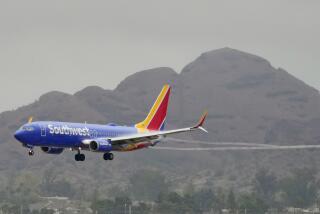Upstart shakes up airline service in Hawaii
- Share via
PHOENIX — Inside Jonathan Ornstein’s spacious, top-floor office is everything one would expect in a CEO’s lair, plus a cranberry-colored scooter parked to the left of his desk.
The brash leader of Mesa Air Group Inc. buzzed around on the 1985 Honda Elite when he first entered the airline industry. It serves as a reminder of his humble start, which included handling baggage.
Depending on whom you ask in Hawaii, Ornstein is either the man who brought competition and reasonable inter-island airfares to the Aloha State or an underhanded businessman trying hard to run his competitors out of business.
“We have five airplanes out there. Four of them fly. One is a spare. Look at all hell break loose because of four airplanes,” Ornstein said. “It’s really remarkable when you think about it.”
Phoenix-based Mesa launched Go airlines on June 9 as the third inter-island jet carrier in Hawaii, entering the market dominated for decades by Hawaiian Holdings Inc.’s Hawaiian Airlines and Aloha Airgroup Inc.’s Aloha Airlines.
Mesa’s entry has sparked a brutal and sometimes silly airfare war, with the incumbent carriers matching every special that Go has offered.
A day after Go offered $19 fares, Aloha held a promotion called the “Great Go Away Giveaway,” passing out 1,000 free round-trip tickets while taking a jab at its newest competitor.
Inter-island fares used to run as high as $100 one way, but now they run as low as $29. It’s a traveler’s market in Hawaii, which relies heavily on air travel for inter-island transportation.
Inter-island traffic has increased since Mesa’s entry, reversing a five-year decline caused by rising airfares and more direct flights from the mainland and Asia to Maui, Kauai and the Big Island.
Ornstein said it was only a matter of time before someone stepped in, with Aloha and Hawaiian gouging inter-island travelers to support the high cost of their transpacific operations.
“We were always afraid that it would be someone like a Southwest or a JetBlue, who really could go in and wipe everybody out,” he said. “That’s why we felt we had to get in there ahead of them.”
Hawaiian CEO Mark Dunkerley said Mesa’s decision to enter the market was based solely on the confidential information it obtained as a potential investor during Hawaiian’s bankruptcy proceedings.
“They could read our minds and look at our books. I think that’s what led them into the marketplace,” he said.
Once fierce rivals, Hawaiian and Aloha are now unified in opposing Mesa, and have pending lawsuits alleging that the company improperly used the confidential information to start its Hawaii operations in an effort to drive Aloha out of business.
They cited an e-mail from Mesa Chief Financial Officer Peter Murnane to a consultant that allegedly details Mesa’s plan to drive Aloha out of business.
“We definitely don’t want to wait for them to die, rather we should be the ones who give them the last push.... Clearly if we can get Aloha out of the market without anyone else stepping in this is a home run,” the e-mail said.
Mesa says the claims are without merit, noting it had been studying the market more than a decade.
“People don’t appreciate that competition is good and in the end, it makes everyone better,” Ornstein said.
Hawaiian welcomes competition, Dunkerley said.
“The issue here is not about competition,” he said. “You don’t play poker with people who have seen your hand.”
Island Air, a smaller turboprop operation, has also joined in the fight, saying Go has “damaged yield throughout the marketplace.”
“It is difficult to make a rational business decision when you’re dealing with an irrational pricing structure and a competitor that has the ability to lose money on every flight,” Island Air CEO Rob Mauracher said.
The battle for Hawaii’s skies comes amid record fuel prices and as Hawaiian and Aloha face pressure to perform for new investors after each emerging from Chapter 11.
Industry analyst Bob Mann said the concern of the “big two is that they somehow slip into the perilous third airline slot.”
“That is a risk that any competitors should be and apparently are concerned about, and thus they match price even if their costs cannot match a new entrant,” he said.
Mann said Delta Air Lines didn’t take AirTran Airways seriously in Atlanta and allowed the newcomer to prosper.
Several companies have tried to crack the Hawaiian market but were quickly squeezed out.
Mesa, however, is one of the nation’s largest regional carriers, with 182 jets, 5,000 employees and revenue exceeding $1 billion.
Aloha CEO David Banmiller has called Mesa’s cut-rate airfares a “sham” and a direct attack on the livelihood of Aloha’s 3,500 employees and their families.
“The scare tactics are just an act of desperation,” Ornstein said.
A group of Aloha, Hawaiian and Island Air employees called HERO, for Hawaii’s (Airline) Employees Repelling Ornstein, have created a website at www.dontflygo.com.
Things got ugly last month when the group sent a T-shirt to Ornstein containing a scribbled insult to his Jewish faith, along with profanities.
HERO later apologized for the remark.
Hawaiian and Aloha are fighting back by aggressively marketing themselves as local companies with deep roots in the islands. They are hoping Go will just go away.
Ornstein, however, said he was in Hawaii for the long haul and had plans to replace his 50-seat regional jets with larger planes.
“We have no huge plans of dominating anything. We want to carve out our niche,” he said.
More to Read
Sign up for The Wild
We’ll help you find the best places to hike, bike and run, as well as the perfect silent spots for meditation and yoga.
You may occasionally receive promotional content from the Los Angeles Times.






